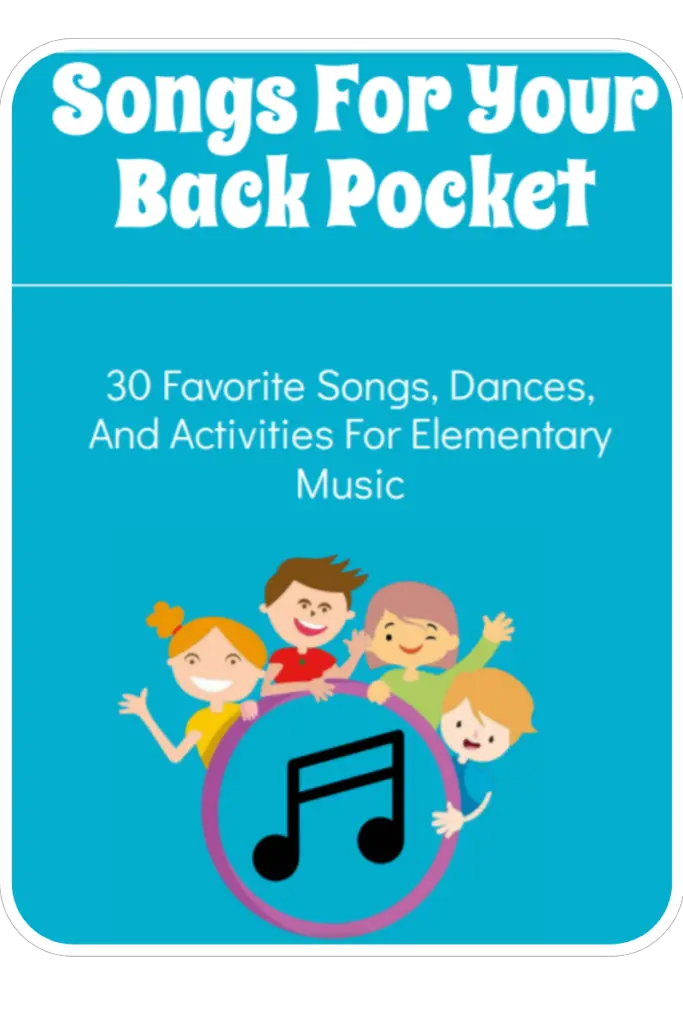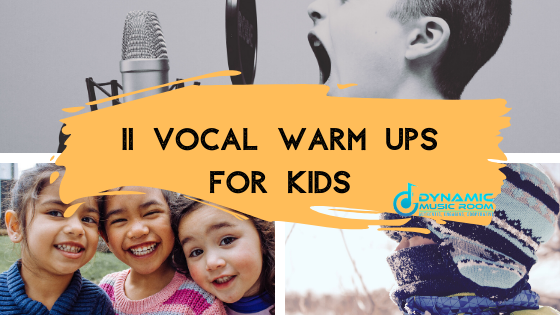Do you want to set your students up for musical success?
Are you looking for different ways to engage all students in stretching their voices?
Vocal warm ups are key to getting elementary students into their head voices and ready for music making. But you may want to mix up your routine with these 11 vocal warm ups for kids.
Vocal warm ups for kids should move from descending to ascending and non-specific to specific pitches in a fun and kinesthetic way. 11 of my favorite warm up activities include:
- Sirens
- Fireworks
- Laser Pointer
- Shape Cards
- Lip Bubbles
- Bean Bag Toss
- Hee-Hees And Ha-Has
- Bubble Gum Man
- Nibble Nibble Crunch
- Scarf Fall
- Animal Sounds
Read on for the directions for each of these warm ups.

Save time with these 60 FREE Music Resources to use in your room right away!
Stop searching the whole internet to find good activities. I’ll help you cut to the chase with my favorite 60 FREE resources.
Table of Contents
How Do You Warm Up Kids?
Warming up voices before singing prevents vocal injury, increases focus, and strengthens the students’ singing ability. And like all good athletes stretch before working out, we need to help students stretch their voices.
There are a few concepts to keep in mind when warming up your students. I’ll go over some of the most important ones briefly.
For more information on warming up, I love Dr. Feierabend’s Book of Pitch Exploration.
Descending First
When students are warming up, it should start with descending high to low sounds. This helps them to better start with their head voice and then stretch the head voice downward to where they may have to sing.
After doing 3-4 descending patterns, then you may have them do ascending patterns.
Non-specific To Specific
Non-specific pitch sounds or sirens are what you need to start with. Having students sing specific pitches is good, but this is the part of your body’s warm up where you’re getting blood flowing to your muscles and beginning to limber up.
With kids, most of my warm ups are non-specific pitches, especially in younger grades. These help get the head voice going without having to worry about pitch matching, although it is waking up the ears to listening for melodic contour.
Once we’ve done at least 10 non-specific patterns, I move into specific pitch patterns. Often, I’ll pick melodies we’ll be working on learning and using in songs that day.
The last pitch pattern I do is the melody of our first song we’re moving to next. It makes for a great transition.
Engage The Body
If you stop to think about it, the vocal cords and the corresponding muscles are actually quite difficult to understand. You feel them to some degree and use them instinctively, but unless you study them, you have little idea how they actually work.
Using the whole body to help the warm up process goes a long way with this.
On top of getting blood flowing, increasing focus, and helping associate height with pitch, body movements while warming up actually help students develop a better understanding of how their body works and how to use their voice more effectively.
Encourage Creativity
During my warm ups, I try to make the time to allow the students to independently create their vocal sounds. This encourages creatively really shows whether or not the student understands why you’re having them warm up in the first place.
I don’t have students do this on the first day or every class, but I encourage it as much as possible. Plus, it builds confidence in their own singing voices.
Props Help
I’m a big advocate for the use of props on occasion. Props are things like scarves, balls, and other manipulatives to help students get a task done.
While I don’t use them with every warm up, I like them because they further develop understanding of singing and pitch, give kids something to focus their attention on, helps engage more students, and offer a shield for students who feel uncomfortable with exposing their voice.
The last reason is one of the main ones I use movement props during warm ups. There are always a few kids who are reluctant to sing. But this almost always disappears as soon as I get out a bean bag to toss around.
Assess In The Moment
Formative assessment may be one of the buzzwords in education, but it’s actually something music teachers have been doing for forever and should continue doing. Formative assessment is basically the act of constantly checking on how the students are doing and helping them as you go.
When doing warm ups, the teacher needs to be right in the middle of it listening to their students and offering specific feedback to help them.
It doesn’t have to be too much. Sometimes all I need to do is make eye contact with a student and point up to help them reach higher for their head voices.
Other times, I’ll need to whisper to them specific directions to use a lighter quality voice. Then at other times, the whole class is singing tired, and I need to change to movements I’m using to be more energetic.
Regardless of what you want to do, formative assessment’s impact is undeniable. In Getting Smart’s article on formative assessment, they find the impact size varies in research but the results are still somewhere between 1-2 years of growth just from this one technique.

Tired of searching and searching for songs that work?
I’m saving you headaches and wasted time spent looking for good activities with this eBook of my 30 favorite songs, dances, and activities for elementary music. Get back to making music right now!
11 Vocal Warm Ups For Elementary Music
In this section, I’ll give the directions for each of my favorite warm ups below. Each of these warm ups can be done with the above elements in mind.
#1 Sirens
There’s nothing special about this warm up, but it does the job well. I first did this warm up when I was in high school choir.
Basically, students are echoing you or creating their own warm up sounds on the syllable “woo” or “wee ooh”. While they do this, their hands and arms should mirror the motion of the pitch.
I prefer the open “ooh” sound with all warm ups if possible because I find it helps students access their head voice easier.
We usually do 3-4 descending, 3-4 ascending, 3-4 mixing it up, and 3-5 specific pitch. Sometimes, I’ll offer the chance for students to quickly make up their own and share around the room.
The whole process takes 2-3 minutes.
#2 Fireworks
Honestly, the Firework warm up is one of my favorites, and I feel proud to say I made this one up. That being said, it shares common elements with the other ones.
Students rub their hands together and whisper “shhh” for the lighting of the fireworks. (This also helps warm the body and air).
Hands and voices echo the teacher as they sing “woooh” for the firework going up and sing “pah” for when it explodes.
I usually do a few more of these, and then I have the students say “ooh” and “aah” like people do for fireworks.
Then, I have students cross their arms and echo a few in a lazy voice with little arm motion. This draws a contrast with how good singing should be.
After this, I have them echo, “boring singing!” and put more energy into their motions as they go back to the correct way for singing.
When we’ve sung a few more, I’ll either ask students to share their own, or we move into the grand finale.
For the grand finale, students watch the teacher and do a whole slew of fireworks and
“Pahs” just for fun at the end.
Note: I won’t do the finale for a class if I sense they’re already not under control. I’ll skip it and move on to the next song.
#3 Laser Pointer
With this warm up, you’re basically doing the same thing as in the Sirens warm up, but now you’re pointing and moving after a laser pointer instead of just your fingers.
The prop will help your students engage more as they do the good warm ups they should. You may even let them control the laser pointer, although I usually only do this part with my older kids.
After all, lasers can severely hurt eyes. But kids do love it when we turn the lights off; it always seems to increase their focus.
#4 Shape Cards
This iconic warm up matches the visual and physical. I first heard of this one from the Book of Pitch Exploration linked above.
Basically, students trace different shapes in the air and sing following the contour of the shape. You or a student holds up the card for the class to sing. Do a few of these and then turn them over and sing them upside down.
For independent practice, students may draw their own shapes on the board for all to see, on individual white boards, or just in the air.
#5 Lip Bubbles
Lip bubbles work great for getting students to stop thinking about singing and just do it! It also works to help build air support, and it’s just plain fun.
I first did these in my high school choir, but younger kids love them too.
You run the warm up just like Sirens or even Shape Cards, but now the twist is that students are singing while buzzing their lips lightly.
Some students struggle with this. It may help them to hold down the corners of their mouth with their fingers.
#6 Bean Bag Toss
For this warm up, I use the bean bag as a prop to help encourage kids to sing.
First, they echo me as I drop the bean bag to get descending patterns.
Then, they sing with the bean bag as I toss it at different heights.
If we have time, and they seem focused, I’ll then toss it back and forth with the kids around the room. Every time they toss it, however, they’re expecting to sing on their own.
I use this chance to assess their singing and provide feedback if needed. When I do provide feedback, though, I’m very careful to not make it a big deal.
If you’re too aggressive or harsh, you may scare off their desire to sing forever. I hedge on the side on not-giving-any-feedback if I can’t privately somehow give them the feedback.
#7 Hee-Hees And Ha-Has
This warm up is based on the common choral warm up which has students sing sol-mi-do patterns on the syllables “hee” and “ha”.
I’ll use these syllables with non-specific pitches first and encourage students to move their hands in a similar motion. But then, I’ll also encourage students to hold their hands to their abdomens to feel how their muscles engage to help with singing.
After you do non-specific pitch ones, you may move into the traditional sol-mi-do patterns descending and ascending by half steps if you want to.
#8 Bubble Gum Man
My students beg for this warm up. I first heard this one when a student teacher brought it in for class, and I loved it.
The silly story connected with it is very helpful for engaging students. He said he first heard it in a video. (I’ll link to one I found at the end).
Over time, my version has changed a little, so I’ll describe how I do it now.
- Students pretend to chew bubblegum and sneeze it out onto their hand.
- They shrug and make it into a bubble gum man.
- The man dances up to an elevator and presses a button with a ding.
- The doors open and close (shoop shoop).
- They ride the elevator to the top (ascending “whoo”), and the doors open and close again.
- Man dances to the edge and goes bungee jumping.
- Sing “woo” while man bungee jumps.
- After 3-5, the rope snaps and the man falls down (“splat”).
- Either re-build the man and repeat or…
- Play the pretend trumpet in honor of the fallen bubble gum man.
- Last pattern you play” is the next song.
#9 Nibble Nibble Crunch
I made up this warm up back in my undergrad choral conducting class. The professor loved it, and it can transition into a more “typical” choral warm up for those who want to use this as well.
Students make mouths with their hands and sing lightly “nibble nibble nibble” while making eating motions with their hands up high.
They watch the leader as their leader moves the “carrot” or “treat” up and down, and their voices and hands move to match.
When the leader claps their hands over the food, the class says “crunch!”
Then, you may either repeat a few times or let someone else be the leader.
After several of these, you may move to a specific pitch. The more traditional warm up will use a descending sol-fa-mi-re-do on the words, “nib-ble nib-ble crunch!”
Then, you move the starting pitch up and down by half steps. Watch out the students don’t get stuck on the “l”, “r”, or “n” consonant sounds; they should aim for the vowels.
#10 Scarf Fall
This warm up may sound simple, but it’s actually a lot of fun.
Students point at the scarf as it falls down and sing in a descending motion. This is basically it, but I came up with a twist just this year.
If you have a fan, drop the scarf onto the fan and follow its contour as it flies around the room. Let kids take turns dropping the scarf; I have no problems using this as a bribe to encourage the reluctant singers.
Check out these ways to use scarves for creative movement.
#11 Animal Sounds
Use animal sounds in combination with the Sirens, Shape Cards, Laser Pointer, or Scarf Fall. Encourage students to come up with their own animal sounds.
This one works well with younger kids. Just make sure to set up your expectations for actual singing and, you know, not going crazy.
Some of my favorites include:
- Meow
- Moo
- Baa
- Tweet
- Hoot
Conclusion
I hope you like this list of 11 vocal warm ups for kids. These are a lot of fun to do and will help your students realize their full singing potential.
Speaking of improving singing potential…
I have to rave about 30 Day Singer. It’s an all online, interactive, comprehensive vocal improvement course.
Even after 20 years of singing I learned so much from the course. It worked for my students too, and I enocurage them to use it.

Get all the experience of singing lessons at a fraction of the price (and at your own speed) with 30 Day Singer.


